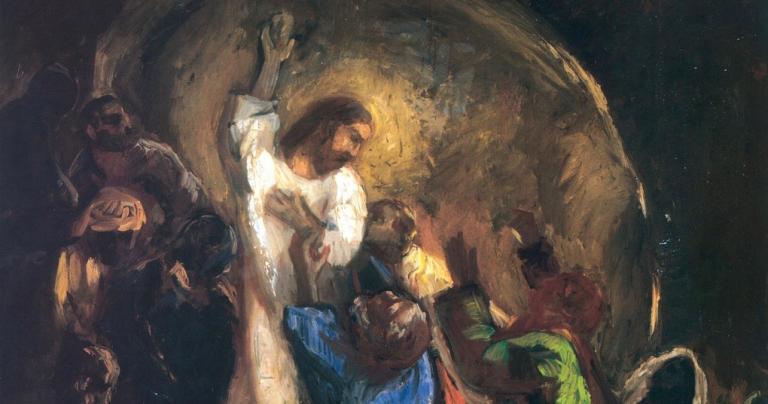The authentic faith of Thomas is difficult to comprehend. We often attribute the characteristics of doubt to Thomas, someone who fluctuates back and forth . . . and possibly . . . he does.
We do know the Disciples met eight days before Jesus appeared to Thomas. Thomas was not with them. He probably has no excuse.
i. There are other aspects to the story that we don’t often hear
I want to touch on one of those. Craig Bartholomew and Michael Goheen wrote a book called The Drama of Scripture: Finding Our Place in the Biblical Story. They said:
“For any Jew, the idea of one person being resurrected in the middle of history is inconceivable . . . ‘the resurrection’ became a vivid image in Jewish thought, implying the coming of the end of the age and the renewal of the cosmos, in which God’s people would participate by their own return to physical life.”[1]
From the beginning, it’s inconceivable to think of Jesus resurrecting in the middle of history. Thomas could be reflecting the mindset of his time, and we’re calling it doubt.
We think of him as the only one who is doubting. If he’s the only one doubting, my question is, why are the other ten Disciples still in hiding after Jesus had already appeared to them eight days earlier? Why are they still behind locked doors . . . still afraid . . . still doubting?
Video: The Authentic Faith of Thomas
Eight days later, they’re all still hiding behind locked doors, and this time with Thomas. This is where Jesus appears again and engages.
ii. Thomas’ life is changed
History reports that he went to the city of Edessa in North East Syria. There he started a faith community, the first one to launch it. Edessa has given us one of the earliest liturgies of all time.
Thomas is said to have traveled as far away as India. It’s common knowledge that he became a missionary to India.
As we think about the grand missionary, the Apostle Thomas, all grand Christian stories must begin with belief. That’s why I think Thomas’ story is important.
Thomas is real. Thomas is authentic. You see this in his other encounters as well in the Gospels. Once he meets the resurrected Lord, his authentic faith is solidified. He has his salvation moment.
To that we turn today, as we look at the last phrase of Christ to Thomas in John 20.29.
Jesus said to him, “Thomas, because you have seen Me, you have believed. Blessed are those who have not seen and yet have believed.” (John 20.29, NKJV)
iii. There is a popular saying, “seeing is believing”
It may surprise some to discover that this beloved phrase is not in Scripture. In fact, in the Kingdom of God, it’s quite the opposite. He doesn’t have to prove anything to you. Believing is seeing.
iv. John develops a very rich understanding of the word believing
If you trace the word believe throughout the book of John, you will be shocked at how many times it occurs. Other terms like faith are all interrelated in the way that John writes.
To believe is to have faith, a related word in the Greek. To believe means something more than what we just think of when we might think of blind faith. Believe actually means to trust. Believe means to trust in, or even to deposit trust into.
In fact, when we think about believe, the way that John develops it, it’s like a bank account. We take our money and deposit it in the bank. With our belief, we are literally taking our faith and depositing it again and again, over time.
We’re not depositing it into any great program at the church. We’re not depositing it into any one personality or charismatic leader.
We are taking our faith over time and continually depositing it in Christ Himself. John makes this very clear in the way that he teaches us about belief throughout his entire book. We are making faith deposits. Our belief and our faith, therefore grows over time like a savings account . . . and this savings account has eternal interest!
It’s a good thing to deposit our faith into God, literally into Christ and who He is.
v. As John shares this moment between Christ and Thomas, John speaks us today
 Doubting Saint Thomas | Bela Ivanyi-Grunwald
Doubting Saint Thomas | Bela Ivanyi-Grunwald
Hungarian National Gallery | Public Domain
Jesus says, “Blessed are those who have not seen and yet believe.”
That’s us, isn’t it?
We live in a time when very few people who walk this earth get a chance to see anything supernatural. If people do see too many things that are supernatural, they get some sort of psychological label. I think we could probably diagnose some of the prophets of the Old Testament if we wanted to. They saw way too much!
vi. Authentic faith is a vibrant faith, a growing faith
We see it again and again in these stories with Thomas, but we can think of many others as well. Do we truly grow into our relationship with God?
We are not just connecting with Him on Sunday, but we are connecting Him to our entire world, Monday through Saturday . . . our families . . . our work . . . our schools.
There are no hidden rooms in our heart, where He can’t open the door, enter, and shine His light. We become real with God.
Integrity is something that follows. Sure, we all still face times when we look in the mirror and say, “I’m a hypocrite.” We all face that, but we grow in our relationship with God. Because, like Thomas, we would do anything to maintain this relationship, we grow closer to Him.
We become the same person on Monday as we are on Sunday. The world looks at us and asks, “Why are you so happy all the time?” Our family looks at us and says, “How can you keep going on with all that’s going on in your life? How do you do it?”
It’s not pride. It’s really humility to know who we are and where we’re at in Christ.
[1] Craig G. Bartholomew and Michael W. Goheen, The Drama of Scripture: Finding Our Place in the Biblical Story (Grand Rapids, MI: Baker Academic, 2004), 166-167.













